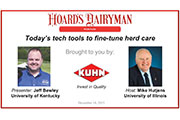
While cows aren't wearing GPS devices, the technology is there to monitor movement, milk composition and eating routines. "I don't know if we need to be measuring everything a cow does, but it is possible to track most of it," remarked Jeffery Bewley.
This University of Kentucky assistant professor is one of the leading authorities on dairy technology. He conducted the December 14 webinar, "Today's tech tools to fine-tune herd care."
In today's world, producers are concerned with animal care, consumer confidence, environmental pressure, labor supplies and economic competitiveness. We need to be able to manage these issues in order to survive and technology can help us.
Modern tools can detect estrus, lameness, mastitis, illness and heat stress to name just a few. But, this technology still needs real "cow people" to interpret and manage the data generated. These new tools help eliminate human bias when evaluating body condition score, mobility and hygiene numbers, for example.
There can be challenges with too much data. "Just because a cow has a high cell count does not mean she has to be treated. The higher count might be a minor infection that her own body quickly handled without incident. But, the data report will show a high count and the manager's gut reaction might be to treat her immediately. You would have never known she spiked if it were not for daily reporting and needlessly treated her.
While a lot of information can be good, having all your systems work together is a huge challenge. Each device has its own programming language and may not be compatible with other systems.
When monitoring devices are gauged to be very sensitive to changes, you can get false positives. You don't want one-third of the herd to appear on the estrus report because you wanted to find every cow that might be in heat.
Bewley's thorough presentation stressed a practical approach to using this fascinating technology. A specific technology might be great on one dairy, but not be best suited on another. Each farm needs to determine which technology will work best for their operation and which tools are needed to make herd decisions.
Many of us are familiar with the science that helps track heats in dairy cows, maintain udder health, and monitor rumen behavior. These tools help us find cows that should be bred, treated or evaluated for off-feed issues, but many more are being introduced and in the pipeline. Watch the archived webinar to learn about these technologies. Kuhn North American (www.KuhnNorthAmerica.com) sponsored the December webinar.
When profit margins are challenged, feed additive are put on the chopping block as dairy managers decide what's left in or taken out of the ration. At the most recent ADSA meetings, over 30 abstracts were presented with new research on this topic. Join us on Monday, January 11, at noon (Central time) as Mike Hutjens presents "An update on feed additives: Probiotics, yeast and niacin." Probiotics or DFM (direct fed microbials) will be featured along with several other additives including yeast products and rumen-protected niacin. Lallemand Animal Nutrition sponsors this webinar.

The author is the online media manager and is responsible for the website, webinars and social media. A graduate of Modesto Junior College and Fresno State, she was raised on a California dairy and frequently blogs on youth programs and consumer issues.








